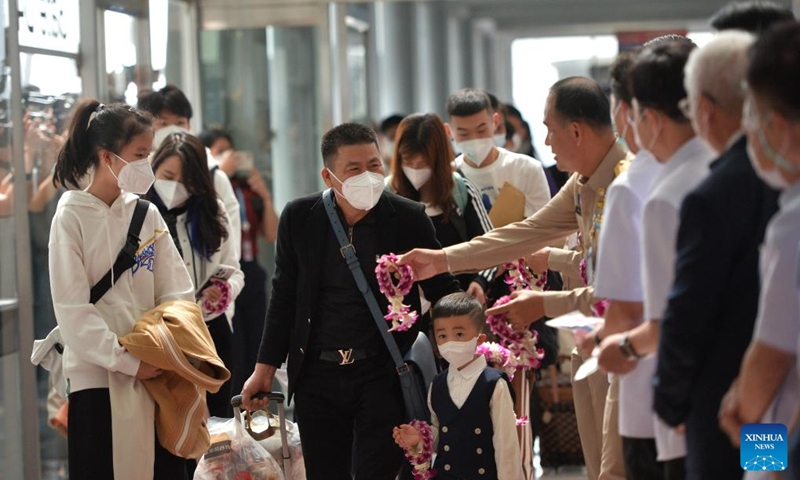On Monday, the first batch of Chinese outbound group tours after the pandemic departed from major cities across the nation, heading to destinations ranging from Thailand, Singapore to the United Arab Emirates (UAE) – for many, it’s a day that ended a three-year anxious waiting. And for the world, it’s a comeback of what was once its world’s largest outbound travel market, it’s also a prelude for a revival of the global tourism industry.
A 24-person tour group for Thailand’s Phuket Island organized by Shanghai Spring Tour is one of the first domestic tour groups to fly overseas since China resumed cross-border group tours. At around 7:30 am on early Monday, the Global Times saw that tourists started to come to the Shanghai Pudong International Airport to check in for the journey, with an obvious sentiment of excitement.
The 6-day trip product was launched on January 20, when China announced the resumption of outbound group travel after a hiatus of more than 1,000 days. The product was sold out immediately that night, Zhou Weihong, deputy general manager of Shanghai Spring Tour, told the Global Times.
The same day, group tourists were also seen at airports of the capital city Beijing and South China’s Guangzhou, leaving for countries like the UAE, Egypt, New Zealand and Singapore.
The domestic enthusiasm for outbound trips has been fueling up recently in the week after the Chinese Spring Festival holidays – the booking volume of outbound group tours products increased by more than three times compared with the holiday period, data from Trip.com showed, reflecting a further recovery of domestic tourists’ confidence in outbound travel.
Demand for long-distance products is also recovering. Trip.com Group, formerly known as Ctrip, told the Global Times that its first New Zealand outbound tour group departing from Shanghai on March 18, with an average price of 27,999 yuan ($4,125) per person, was sold out immediately after it went on sale.
China Eastern Airlines told the Global Times that its international routes are expected to reach 60 by the end of February, with Southeast Asian countries recovering at a faster speed among others.
“I feel really happy, as this journey makes me feel that people’s lives are returning to normal after the lengthy combat with the coronavirus,” one tourist told the Global Times at the Shanghai airport on Monday. She also said that she’s thinking of traveling to Egypt this year to make up for regrets, as her travel plan in 2020 was aborted because of COVID-19.
The 20 countries for pilot outbound group travel included Thailand, the Maldives, the UAE, Russia and New Zealand. Pre-pandemic hot destinations like South Korea and Japan are out of the list.
The announcement has sparked a frenzy of trip planning and seen online searches for overseas destinations spike, with Thailand sticking hold to most popular destination among all.
“Chinese tourists are prone to choose countries that offer convenient, quick and favorable entry policy as their first stop, we are also exploring for more tourism products based on that demand, and make sure they won’t be ‘aggrieved’ by some discriminative policies during the whole trip,” Xu Xiaolei, marketing manager at China’s CYTS Tours Holding Co, told the Global Times on Monday.
Global welcome
The policy change from the world’s second-largest economy has received a positive response from many countries, with officials and tourism practitioners across the world preparing for ceremonies and souvenirs in high anticipation for the return of Chinese tourists.
“We have been waiting a very long time for this moment, but finally we make it,” Nonglux Yooyendee, director of the Tourism Authority of Thailand Shanghai Office, who came in person to see the tourists off at a Shanghai airport, told the Global Times on Monday.
The official expected that Thailand will have about 5 million Chinese tourists this year, which is about 50 percent of pre-pandemic level.
Senior Thai government officials also lined up at a Bangkok airport on Monday morning to receive the first group of tourists from Guangzhou. Chinese-language banners were set up at Don Mueang International Airport to greet Chinese tourists, which read “Thailand always welcomes Chinese friends.”
Chinese were the largest group of visitors to Thailand before the pandemic, accounting for about 28 percent of the record 40 million foreign arrivals in 2019, according to a report from Bloomberg.
Welcoming ceremonies will also be held in Dubai and Egypt. According to media portal thepaper.cn, Chinese tourists will be greeted by local officials at the airport after their arrival in Dubai, and the 7-star Burj Al Arab Hotel will provide tourists with “early check-in” service for the first day.
In Egypt, the local government will hold a welcome ceremony for Chinese tourists on the cruise ship in Aswan, and will present exquisite souvenirs.
“We are very happy to be able to welcome Chinese visitors back to New Zealand as China is one of New Zealand’s most important markets,” Gregg Wafelbakker, the General Manager Asia of Tourism New Zealand, told the Global Times.
“China was New Zealand’s second largest market pre-COVID. Chinese visitors contributed over NZ$1.7 billion to New Zealand’s economy in 2019,” said Wafelbakker.
Daniela Chiani, Director Greater China of Switzerland Tourism, told the Global Times that Switzerland is honored to appear on the first batch of 20 pilot countries, and has made “every preparation” for the return of Chinese tourists.
Apart from a stronger spending power compared with independent tourists, industry players said the comeback of large number of Chinese group tourists can help local tourism industries quickly restore confidence, build up capabilities, hiring, thus empowering a vital recovery.
In 2019, Chinese citizens made 155 million outbound trips and spent more than $133.8 billion, according to data released by the China Tourism Academy.
“It’s still a prelude,” Xu Xiaolei said, introducing that the company now only launched 200 “basic” products for the first pilot 20 countries at the moment, about one tenth of the number for the pre-pandemic level in 2019.
“We expect by the end of the first quarter, or the beginning of the second quarter, China will resume group tour services for more countries, in preparation for the traditional ‘travel golden period’ starting from May,” Xu said.
Economic recovery
For countries that rely on tourism revenue, the comeback of Chinese tourists has brought hopes of economic rebound, and more importantly, adds optimism and helps them pull through from a possible economic downturn.
The effect of stronger tourism activity due to the resumption of China’s outbound group tour could boost Malaysia’s GDP by at least 1 percentage point, UOB Global Economics & Market Research said on Friday, the Xinhua News Agency reported.
According to the research house’s economists, the boost will further support their baseline GDP growth forecast for Malaysia of 4 percent for 2023.
Thailand’s economy may accelerate and hit the 3.8 percent growth forecast provided its tourism sector will get a vital boost from China’s reopening plans, according to a Reuters report in December, citing the Thai finance minister.
Fitch Ratings said China’s reopening is expected to further lift the tourism economy across the Asia-Pacific region. “We expect a revival of Chinese outbound tourism to boost growth prospects in economies with substantial tourism sectors. Further upsides to government credit profiles could stem from its positive effect on domestic employment markets and the external services trade balance,” Fitch Ratings said in a report sent to the Global Times.
China’s resumption of outbound group tours could bring more than $200 billion back to international tourism, the Financial Times reported in January.
Due to the earlier-than-anticipated recovery after China’s optimization of its COVID measures, the International Monetary Fund (IMF) raised its forecast for China’s economic growth in 2023 to 5.2 percent a few days ago, up 0.8 percentage points from its projection in October, driven by a rebound in private consumption.
The estimated 5.2 percent growth in China will contribute greatly to the global growth this year, Thomas Helbling, deputy director in the IMF’s Asia Pacific Department, told the Global Times during a virtual press briefing on Friday.
The official noted that spillovers of China’s rebound will particularly be where there are strong trade linkages in tourism with many of the Asian neighbors including Thailand or the Philippines. “Of course, the larger these linkages, the bigger will be the impact,” Helbling said.













